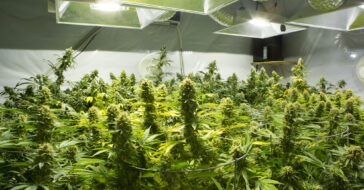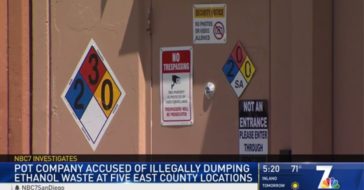For cultivators, there’s nothing worse than seeing mold on cannabis plants. Not only do common cannabis molds grow rapidly, but they can also spread across your entire crop in extreme circumstances. Fortunately, with the proper precautions and a cannabis mold treatment plan, you can avoid costly cannabis mold outbreaks.
To help you navigate this worrisome issue, our cannabis experts have put together a comprehensive guide. Continue reading to educate yourself on identifying common molds, proper disposal practices, and prevention tips.
Early Identification of Molds
In growing, it’s not every day that you need to defoliate or come in close contact with plants. Most operations have feeding and watering on autopilot, and until it’s time to de-leaf, it can be days or weeks until individual plants are inspected—especially those in the middle of the plot or field.
To get ahead of cannabis mold issues, top-tier cultivation operations have inspections for mold built right into their standard operating procedures. By training the crew on signs of mold growth and routinely monitoring the crop for those signs, facilities can quickly identify and rectify issues before they impact the entire crop.

3 Most Common Types of Mold on Cannabis Plants
So, what are some of the most common cannabis molds to keep your eye out for?
- Powdery Mildew AKA “PM”: While there’s a variety of powdery mildew types, there’s one common factor they all share: PM can be detrimental to the health of the crops as it halts plant growth and makes the flower unsafe to consume. Powdery mildew initially appears as a white mold on cannabis plants that looks somewhat dusty. The mildew, actually called mycelium, typically shows up on fan leaves first, so be sure to inspect and routinely defoliate thoroughly. PM can affect veg and flower plants, so it’s best to be on high alert, especially if growing in a greenhouse where humid conditions and warm temperatures can spawn its growth.
- Botrytis AKA “Bud Rot”: If you start to see grey mold on cannabis plants during flowering, it’s likely botrytis or bud rot. The patches start as fuzzy grey mold and quickly wilt the buds turning them brown and unsmokeable. If botrytis is present, you’ll also notice leaf tips transform from yellow to brown over time.
- Fusarium: Fusarium is a less common cannabis mold on soil that is especially devastating considering it affects the plants’ roots. Fusarium will cause root rot, affecting the photosynthesis process of delivering nutrients to the plant. The first sign of the mold is wilted leaves.
Ultimately, your goal should be to maintain a mold-free grow room. If you’re wondering how to do that, this next section is for you.
Tips to Minimize Chances of Mold Growth
If you’ve ever dealt with the repercussions of a cannabis mold outbreak, then you know how costly it can be. Not only do you have to purchase additional foliar sprays and rack up hours to fight it, but in extreme cases, you may lose multiple plants or an entire crop.
To successfully prevent cannabis mold growth in your indoor or outdoor cultivation facility, keep the following tips in mind.
- Regularly monitor humidity levels and temperatures to maintain optimal conditions. Mold can grow and prosper with even short periods of high heat and high humidity.
- Ensure your fan and exhaust system are operating properly at all times to ensure air circulation.
- Grow strains that are naturally mold-resistant, especially in outdoor growing environments.
- Defoliate plants before flowering to allow for optimal airflow.
- If you’re an outdoor grower, have a tarp system ready for long periods of rain that can cause mold growth.
- Use Trichoderma in outdoor soil to prevent the growth of fusarium.
- Implement a neem oil regimen to treat plants with powdery mildew. If possible, remove and isolate the plants from other crops until the mold growth has ceased.
- Remove and prune portions of plants affected by bud rot or powdery mildew.
- Sterilize all tools used for treatment or removal thoroughly to avoid spreading mold spores.
On that same note, discarding the part of the plants affected by mold is crucial to stopping the spread. So lastly, let’s cover the proper disposal of cannabis molds.
How to Dispose of Moldy Cannabis
One of the most critical factors in minimizing the spread of mold is the proper isolation and disposal of impacted plants. You don’t want to keep cannabis plant waste affected by mold in or even near your facility. Spores can easily grasp onto the clothes of your grow team or tool surfaces and travel to other parts of the operation. To avoid cannabis molds spreading, it’s best to dispose of plant waste securely and safely.
Having a trusted cannabis waste disposal company at your disposal (pun intended) is of high importance when unexpected outbreaks and issues occur. Not only can their experience help guide you in properly disposing of cannabis molds, but they can also ensure you’re following all the required rules and regulations for compliance too.
The Bottom Line
Successfully managing cannabis cultivation operations can feel like a juggling act, and overseeing the proper disposal of cannabis mold is the last thing you need to worry about. That’s why so many facilities are now outsourcing cannabis waste disposal to the experts.
From disposing of moldy plants to disposing recalled products, the Bureau of Cannabis Control has a compliance requirement for everything and anything. Of course, if you make a mistake – you can be subject to hefty fines and even a suspension of your license.
By partnering with a comprehensive cannabis waste disposal provider like Easy Cannabis Waste, you can reduce compliance risk and free up resources to scale the growth of your business. Contact our team to set up a free consultation and begin building a roadmap to success now.
















































































